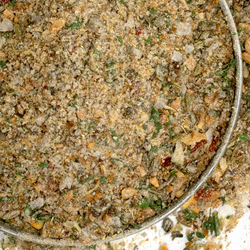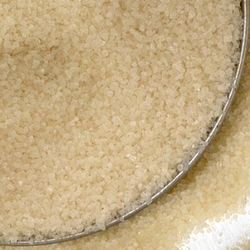Savory Croissants with Amalfi Seasoning

Croissants require a lot of time and attention--think days, instead of hours--but there is nothing inherently difficult in making a batch of croissants, other than the waiting. Yes, dough can be finicky. Yes, you need plenty of time to make these properly and yes, some of the instructions are precise, but in the end, you’ll have a flaky roll of savory dough that’s perfect for any meal, and may change how you feel about pastry.
If you can, choose a butter with a butterfat content of at least 82%. This will help create flaky layers and rich flavor. Once this meant croissant makers should purchase European butters, but in recent years artisanal butter makers in the US have been creating butters that are comparable their European counterparts. Regardless of the kind you choose, remember that the higher butterfat percentage is preferable.
Prep time noted below is for the final day of cooking only. There will be substantial amounts of time needed before their final preparation and cook time; we suggest giving yourself 2-3 days to successfully complete this recipe.
4 cups all-purpose flour, plus more for dusting
1/4 cup plus one teaspoon Turbinado Sugar, divided
2 1/2 teaspoons Fine Sea Salt
2/3 cup warm water (100-110°F)
1 Tablespoon active dry yeast (you will need two packets)
1 1/2 cups plus 3 Tablespoons cold unsalted butter that is at least 82% butterfat, divided
2 Tablespoons Amalfi Seasoning Blend
1/2 cup whole milk or half and half
1. Stir together flour, 1/4 cup Turbinado Sugar, and Fine Sea Salt in a medium bowl and set aside. Put warm water, yeast, and 1 teaspoon Turbinado Sugar in the bowl of a stand mixer. Let it stand until it is foamy, approximately 5 minutes.
2. Take butter out of the refrigerator. Set 1 1/2 cups aside to soften. Put remaining 3 Tablespoons butter in a bowl and microwave it for 30 seconds, or until it is liquid but not too hot; if butter is too hot cool it down with a touch of milk so it doesn’t kill the active yeast. Add to yeast mixture and stir to combine.
3. Fit the stand mixer with a dough hook. Run the mixer on low speed, and incrementally add the flour mixture to the yeast mixture until all the dry ingredients are incorporated. Then increase the speed of the mixer to medium-low and beat until the dough is smooth, elastic, and sticky, 8-10 minutes. Lightly flour a large plate, then remove the dough. Flatten it into a disc and wrap it tightly in plastic wrap. Refrigerate at least two hours and up to overnight.
4. Place the softened butter in a large mixing bowl. Add Amalfi Seasoning to the butter and mash until thoroughly combined into a compound butter. Scoop onto a piece of plastic wrap, flatten into a large square, and refrigerate at least two hours or overnight.
5. When you’re ready to start working the dough with the butter, remove cold butter and place it between two sheets of parchment. Let it sit at room temperature for 10 minutes to soften, then pound and shape butter into a 7 1/2 inch square of even thickness. Make sure parchment is in place on top and bottom of the butter and return to the refrigerator for at least 15 minutes.
6. Remove chilled dough from the refrigerator and move to a lightly floured surface. Lightly flour the top of the dough and your rolling pin, then roll dough to a 12-inch square. Take the cold block of butter and flip it so it sits like a diamond in the middle of the square dough, removing parchment paper.
7. Roll the long corners of the dough out until the corners are about 8 inches long, flouring as necessary as you roll. Then take the corners and fold over the butter block, gently stretching them so each corner becomes a layer that roughly covers the butter block.
8. Roll dough, with the butter in the middle, into a 24 x 12 inch rectangle, flouring and turning as needed to reach the proper size. Fold in one of the short sides to the middle, and then fold the other side over it, into a trifold. Move to a lightly floured baking sheet. Cover tightly with plastic wrap and refrigerate until firm, at least 45 minutes or up to overnight.
9. Repeat rolling, folding, and chilling two more times. After each fold, you can chill the dough overnight, if needed.
10. To make the croissants, line two baking sheets with parchment paper. Place refrigerated dough on a lightly floured work surface, then lightly flour the dough and your roller. Roll once more into a 24 x 12 inch rectangle.
11. Using a pizza cutter or a very sharp, thin knife, trim edges and cut dough into a 23 x 11 inch rectangle; discard dough scraps. Then mark the long bottom edge at 3 1/2 inch intervals. On the long top edge, mark dough at 1 3/4 inches, and then every 3 1/2 inches after that. Cut from the bottom left corner to the top 1 3/4 inch mark, then back down to the next mark on the bottom to form a triangle. Continue cutting triangles in the dough until all the dough has been divided up. Throw away scraps.
12. Place triangles on a baking sheet lined with parchment paper. Cover with plastic wrap and place in the refrigerator for 15 minutes.
13. After 15 minutes, stretch dough to make elongated triangles; use a rolling pin if necessary to get them to reach about 13 inches in length. Starting with the wide end of the triangle, begin rolling your croissant. Press the point into the dough, and place it point side down on a baking sheet. Continue until all croissants are rolled, placing them 2 inches apart on the prepared baking sheets. At this point, you can refrigerate up to 8 hours, or continue with the recipe.
14. Whisk egg and milk in a small bowl. Brush croissants lightly with egg mixture, and put remaining egg mixture in the refrigerator. Proof the croissants by putting them in an unheated oven (or a similar space that will maintain a steady temperature and will protect dough from breezes) next to a bowl that contains two cups of boiling water. Leave in the oven for two hours. Do not open the oven door or use the stove while the croissants proof.
15. Remove croissants and water from the oven. Let croissants stand at room temperature for 30 minutes. Discard the water. Preheat the oven to 425°F. Make sure the oven rack is in the middle position.
16. Right before baking, brush croissants with the rest of the egg and milk mixture. Put in the oven, and immediately drop the heat to 375°F. Bake until golden and crisp, approximately 25 minutes. Repeat with the second tray of croissants, if the middle rack is not large enough to accommodate both trays.
17. Croissants are best if they are eaten the same day they are baked. Serve with more compound butter, as part of a cheese board, or with some ham and mustard.




